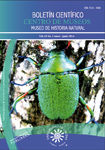Authors
Abstract
In the integrated pest management the use of several biological control agents is common such as the entomopathogenic fungi (EF) and nematode parasites of insects (NE). These two pathogens may have the same host and habitat, leading to the appearance of synergism or antagonism relations when colonizing the same host. Based on the foregoing, this work had as main objective to study the interaction that can occur between Beauveria bassiana (Bb) and Steinernema sp. (Ss) in the lepidopteron Galleria mellonella (GM) larvae individually and as a group. The experimental unit was composed of six GM larvae from 24 wells placed in tissue culture dishes, with filter paper. Bb was used in a concentration of 1 x 103 (n= 9) spores/ml per larvae and Ss was used in a concentration of 100 infective juvenile (IJ) per larva. Sterile water was used as control. In general, it could be found that the percentage of mortality at 48 hours, for the treatment in which simultaneous application was performed, was higher and statistically different from that of individual treatments. In relation to the development of Ss, although there were no significant differences concerning the differentiation of sexes, there was decreased production of infective juveniles and penetration rate (variables evaluated to establish the effect of the fungus on the nematode). In the case of fungus, its sporulation was significantly reduced. Finally, although there is an increased effectiveness in pest control when pathogens are used together, the development of each of the organisms is affected possibly by competition for the host in which case, the agent that colonizes first dominates. In general terms the understanding of these interactions on a specific target insect will make it possible to determine the compatibility of the components of biological control to be used and will help increase the efficiency in the reduction of the pest.
References
ANSARI, M.A; SHAH, F.A; TIRRY, L. & MOENS, M. 2006. Field trials against Hoplia philanthus (Coleoptera: Scarabaeidae) with a combination of an entomopathogenic nematode and the fungus Metarhizium anisopliae CLO 53. Biol. Control., 39: 453-459.
ANSARI, M.A; TIRRY, L. & MOENS, M. 2004. Interaction between Metarhizium anisopliae CLO 53 and entomopathogenic nematodes for control of Hoplia philanthus. Biol. Control 31: 172-180.
BARBERCHECK, M.E. & KAYA, H.K. 1990. Interactions between Beauveria bassiana and the entomogenous nematodes, Steinernema feltiae and Heterorhabditis heliothidis. J. Invertebr. Pathol., 55, 225–234.
BARBERCHECK, M.E. & KAYA, H.K. 1991. Competitive interactions between entomopathogenic nematodes and Beauveria bassiana (Deuteromycotina: Hypomycetes) in soilborne larvae of Spodoptera exigua (Lepidoptera: Noctuidae). Environ. Entomol., 20, 707–712.
FINNEY, J.R. 1981. Potential of nematodes for pest control. (en) BURGES, H.D. Microbial Control of pest and plant diseases 1970 – 1980. Academia Press, London, Inglaterra.
HU, K. & WEBSTER, J.M. 2000. Antibiotic production in relation to bacterial growth and nematode development in Photorhabdus-Heterorhabditis infected Galleria mellonella larvae. Microb. Lett., 189, 219– 223.
ISAACSON, P.J. & WEBSTER, J.M. 2002. Antimicrobial activity of Xenorhabdus sp. RIO (Enterobacteriaceae), symbiont of the entomopathogenic nematode, Steinernema riobrave (Rhabditida: Steinernematidae). J. Invertebr. Pathol., 79, 146–153.
KAYA, H. K.; THURSTON, G.S. 1993. Soil microorganism affecting entomopathogenic nematodes. (en): BEDDING, R,A.; AKHURST, R.J. & KAYA, H.K (eds). Nematodes and the biological control of insect pest. CSIRO Information Service, East Melbourne, Australia.
KAYA, H. K. & GAUGLER, R. 1993. Entomopathogenic nematodes. Annu. Rev. Entomol. 38: 181 - 206.
MOLINA, A. J.P.; SAMUELS, R.I.; MACHADO I.R. & DOLINSKI, C. 2007. Interactions between isolates of the entomopathogenic fungus Metarhizium anisopliae and the entomopathogenic nematode Heterorhabditis bacteriophora JPM4 during infection of the sugar cane borer Diatraea saccharalis (Lepidoptera: Pyralidae). J Invertebr Pathol 96:87-192
SHAPIRO-ILAN, D.I; BRUCK, D. & LACEY, L.A. 2012. Principles of Epizootiology and Microbial Control. (en) VEGA, F.; KAYA, H. (eds) Insect Pathology. Academic Press, San Diego.
SHAPIRO, D.I.; JACKSON, M.; REILLY, C.C. & HOTCHKISS, M.W. 2004. Effects of combining an entomopathogenic fungi or bacterium with entomopathogenic nematodes on mortality of Curculio caryae (Coleoptera:Curculionidae). Biol. Control., 30: 119-126.

 PDF (Español)
PDF (Español)
 FLIP
FLIP


















